Norvic Philatelics - GB New Stamps and Special Postmarks
The Houses of Lancaster and York - 28 February 2008 - stamps and
miniature sheet
The Houses of Lancaster & York are the first in an annual series
that will take a look at the Kings
and Queens of England, Scotland and after 1603 the United Kingdom. The
first in the series looks
at the period between 1399 and 1485 a period riven with social unrest,
war in France and a dynastic
quarrel between the Royal House of Lancaster and York commonly known as
the War of the Roses
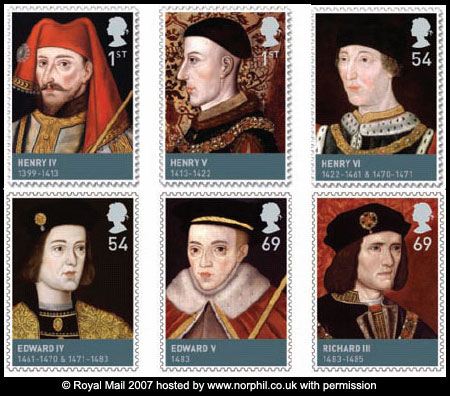 |
1st class: Henry IV (1399-1413) &
Henry V (1413-22);
54p Henry VI (1422-61 & 1470-71) &
Edward IV (1461-70 & 1471-83);
69p Edward V (1483) &
Richard III (1483-85)
Portrait of Henry VI (1421-71) c.1550 by English School;
all others by unknown artists.
|
|
|
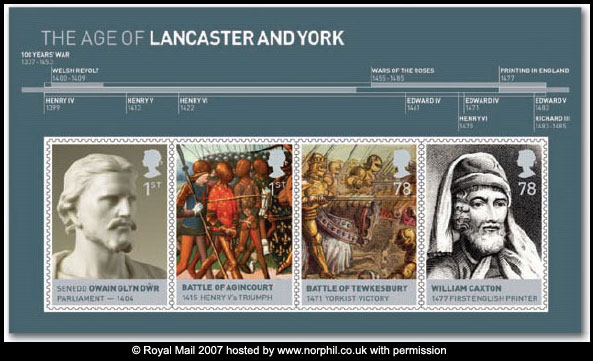
|
The MS takes a separate look at the life and times of the age,
with four events from
the reign of the Houses of Lancaster and York.
Owain Glyn Dwr's rebellion and the Welsh Parliament in
1404, Henry 5th triumph at the Battle
of Agincourt where the English archers defeated a superior
force of
French knights in 1415, the Battle Tewkesbury where the
forces of York finally
defeated the Lancastrians in 1471 and William
Caxton the first man to operate a printing process in
England in
1477
|
| Owain Glyn Dwr statue by Alfred Turner courtesy
of City Hall Cardiff photograph © Pete Wood; The Battle of
Agincourt, 1415, by Martial de Paris (known as Auvergne) c.1484,
Bibliotheque Nationale, Paris/The Bridgeman Art Library; Battle of
Tewkesbury and William Caxton, Mary Evans Picture Library |
Background on the stamps
1st Class - Henry IV (1399-1413)
Son of John of Gaunt (himself 4th son of Edward III) - surnamed
Bolingbroke from his place
of birth. In 1397 supported his cousin Richard II and was created Duke
of Hereford. But was
banished in 1398, and his estates were forfeit to the crown when his
father died in 1399.
Returned that year and persuaded Richard II to sign renunciation,
crowned king: Richard died
(of starvation - or probably murdered) in Pontefract castle. Endemic
war with France, Scotland
and Wales during his reign. Battle of Shrewsbury (1403) saw defeat of
Scots and Welsh.
1st Class - Henry V (1413-1422)
Son of Henry IV, born at Monmouth. Succeeded 1413. In 1414 claimed
throne of France. In
1415 defeated the French at the Battle of Agincourt. Concluded the
'perpetual peace' of Troyes
with France in 1420, which recognised him as regent and heir to the
French throne. Married
Catherine of Valois, the French king's daughter, and died at Vincennes
1422.
54p - Henry VI (1422-1461 then 1470-1471)
The only child of Henry V and Catherine: during his reign the French
recovered most of France.
Married Margaret of Anjou in 1445. Beginning of the 'Wars of the
Roses:' Henry was captured,
restored to the throne, captured again and eventually murdered. Founded
both Eton and King's
College Cambridge.
54p - Edward IV (1461 1470 then 1471-1483)
Son of Richard Duke of York. Led the Yorkists after his father's defeat
and death at the battle
of Wakefield (1460). Won the crown at the battle of Towton (1461). But
his behaviour (and an
unwise marriage to Elizabeth Woodville) upset many of his supporters.
He was compelled to flee
abroad, but returned in 1471, first beating the Earl of Warwick at the
Battle of Barnet and then
going on to defeat Margaret of Anjou at Tewkesbury, where her son
Edward was killed after the
battle. Henry VI, already captured, died 'of a broken heart', in the
Tower.
69p - Edward V (1483)
On his father's death he was brought from Ludlow to London, but
intercepted at Northampton
by his uncle Richard Duke of Gloucester, who shortly afterwards became
Protector. Lodged in
the Tower with his brother Richard, the Duke of York. Almost certainly
murdered, although it is
impossible to be certain who was responsible.
69p - Richard III (1483-1485)
Younger brother of Edward IV. Created Duke of Gloucester after his
brother's accession. Believed
to have had a hand in the murder of Lord Edward after the Battle of
Tewkesbury. Proclaimed
king (having secured both the sons of Edward IV) in 1483. An attempted
rising concocted by
Richard's erstwhile supporter the Duke of Buckingham and Henry Tudor,
Earl of Richmond,
collapsed, and Buckingham was executed. But in 1485 Henry landed at
Milford Haven: Richard
met him near Market Bosworth, and was killed in the ensuing battle.
Henry became king as
Henry VII, starting the Tudor dynasty.
Miniature Sheet
1st Class - Welsh Parliament of Owain Glyn Dwr
By far the most significant event of this period in Wales was the
revolt of Owain Glyn Dwr, who
was proclaimed Prince of Wales on 16 September 1400 and led a revolt
that sought to end
English rule in Wales and thereby recreate a principality of Wales that
would reverse the
conquest achieved by Edward I in 1282-4.
The revolt spread across the whole of Wales, and for a few years Owain
enjoyed authority over
more of the country than had any native Welsh ruler since the mid-11th
century. However, the
English crown - thanks especially to the military leadership of Henry,
Prince of Wales (the future
Henry V) - succeeded in overcoming the revolt, and Glyn Dwr's cause was
in decline by 1408-9;
he disappears from the sources in 1415 and probably died in that year
or shortly afterwards.
The revolt was the last major attempt to achieve Welsh political
independence through military
force, and is thus a major turning point in the history of Wales as a
whole.
1st Class - Battle of Agincourt 1415
Probably one of the most famous victories of the 100 years war where
Henry V's English
army took on a larger force of French Knights and won.
78p - Battle of Tewkesbury 1471
The Battle of Tewkesbury in Gloucestershire one phase of the Wars of
the Roses. It put a
temporary end to Lancastrian hopes of regaining the throne of England
There would be
fourteen years of peace before another political coup in the form of
Henry Tudor finally
settling the dispute between the two dynasties.
78p - William Caxton and the Printing Press
In 1475 William Caxton brought the fruits of movable type printing to
the English language,
publishing the first English printed book, the Recuyell of the
Historyes of Troye, at his Bruges press.
Just a year later he had set up his press in Westminster. The age of
mass media began to dawn.
Technical details:
The designs are by Atelier Works, and the 27 x 37mm stamps are
printed in litho by Cartor Security Printers.
The miniature sheet is 123 x 70mm.
All images are Copyright Royal Mail 2007/08.
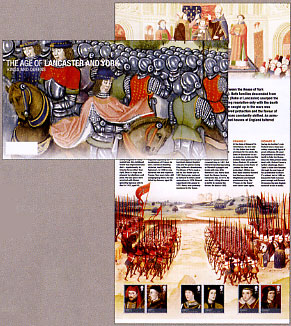
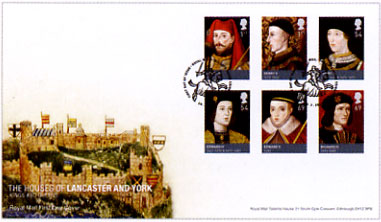 Products
available:
Products
available:
There will be no Norvic first day covers for this issue.
Mint set
Mint miniature sheet
Presentation Pack (set & MS)
Set on PO FDC
MS on PO FDC
Set of 11 Stamp Cards unused
Special Postmarks
Postmarks available for the day of issue are shown here - these may
not be to scale. These postmarks cannot be obtained after the date
of issue.
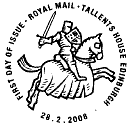 |
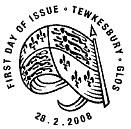 |
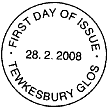 |
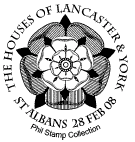
|

|
Ref FD805
Philatelic Bureau Official Postmark |
Ref FD806
Tewkesbury Official Postmark |
Ref FD806NP
Tewkesbury non-pictorial Postmark |
Ref L10863
The Houses of Lancaster & York, St Albans |
Ref N10872
The Houses of Lancaster & York, Henry VI - Richard III |
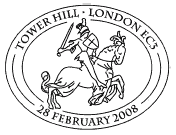
|
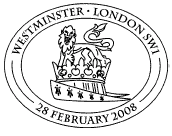
|

|
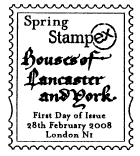
|
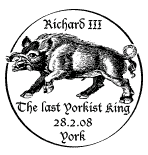
|
Ref L10865
Tower Hill, London EC3 |
Ref L10864
Westminster, London SW1 |
Ref L10862
First Day of Issue Royal Mail Westminster London SW1 |
Ref L10867 Spring Stampex, Houses of Lancaster & York,
First Day of Issue, London N1 |
Ref N10874
Richard III The last Yorkist King, York |
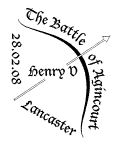
|
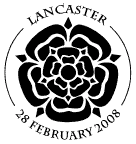
|
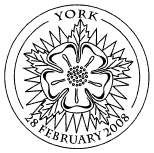
|
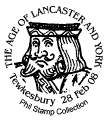
|
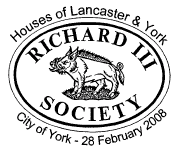
|
Ref N10873
The Battle of Agincourt, Henry V, Lancaster |
Ref N10876
Lancaster |
Ref N10877
York |
Ref M10871
The Age of Lancaster and York, Tewkesbury |
Ref N10879
Richard III Society, City of York |

|
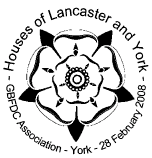
|
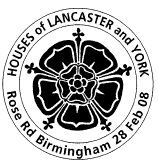
|
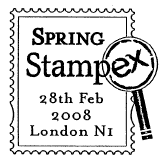
|
Ref N10878
Kings & Queens of England, York |
Ref N10880
Houses of Lancaster and York, GBFDC Association, York |
Ref M10870
Houses of Lancaster and York, Rose Rd, Birmingham |
Ref L10866
Spring Stampex, London N1 available for 27, 28, 29 Feb & 1
March |
If you would like to know when this page is updated, please use the
ChangeDetection panel next to the stamp images.
If you have any questions about these stamps please email
us.
NB: all emails should be acknowledged in 1-2 days
unless the office is closed. If you do not receive an acknowledgement
please email us from a different address (eg hotmail, gmail).
This page updated 16 March 2008



 Products
available:
Products
available:


















